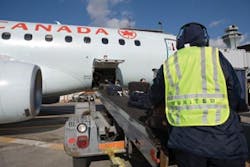United Services, a business within United, is comprised of three separate divisions including MRO, flight training and ground handling. In 2004, in conjunction with United, United Services restructured their organization’s key businesses through management realignment and the strengthening of their customer service department.
The past five years have been rather tough on the airline industry, United having been no exception, being one of several legacy carriers to file for bankruptcy. However, United Services, by maintaining operations with a “business as usual” approach and strong customer service, remains viable. “We emphasized that [the customer] would see no hiccup in any of our services … no discontinuity,” says Mike Gentile, director, airport services. “United as an airline is committed to the business concept of United Services Ground Handling.”
Priority, Commitment and Restructuring
The ground handling division of United Services was started in 1985, fell off for a time, was resurrected in 1995 and has been proactive by aggressively pursuing new clients for the past 10 years. United Services currently has over 90 customers worldwide, , the major customers being Air Canada and Lufthansa through the Star Alliance Partnership.
While other major carriers have been outsourcing portions of their ground handling business, United Services with a priority of quality service and a commitment to contain costs, was determined to “maintain economy and control of their own product.”
Another part of United’s commitment was restructuring labor costs. Until recently, due to the increasing fuel prices, labor had always been an airline’s greatest expense. But United has worked consensually with its unions not only to restructure salaries and benefits, but to overhaul employee rules and practices. For example, the receipt and dispatch function at the gate, prior to the first round of negotiations in bankruptcy, always had to be handled by a licensed mechanic. “We negotiated to have that function performed by a ramp serviceman,” says United’s Spokesperson, Brandon Borrman. “We were able to use our line mechanic group more efficiently while improving the efficiencies of our ramp workers as well.”
NASCAR on the Ramp?
Makes perfect sense if you are looking for ultimate teamwork and efficiencies. A motor sports pit stop used to be a minute and a half. The NASCAR pit crew has it down to less than 13 seconds now. Launched in February, United joined forces with PIT Instruction and Training LLC, a training facility in Mooresville, N.C., to develop Pit Crew U, a course designed to create a culture of change in ramp operations utilizing the standard work, efficiencies and clearly defined sequence of tasks performed by pit crews. “This unique training experience is an innovative investment in our front-line leadership,” says Jeff Hughes, program manager lead and service director development. “The similarities between an efficient pit crew team and ramp operations professionals are virtually the same. Crews are ready on arrival, whether it’s waiting to pit a race car or receive a United aircraft; both have standard tools and equipment to perform their jobs.”
To date, more than 203 lead ramp professionals, service directors and ramp operations leadership have been trained in Pit Crew U and a total of 1,170 will complete the training in 2006. Al Frank, lead ramp professional at ORD claims, “This is the best training I have experienced in 36 years at United.”
According to United, by applying the PIT Instruction and Training principles, they are gaining use of additional airplanes without purchasing additional aircraft and United continues to improve its processes through standard work packages with resource optimization and ongoing training initiatives.
Resource Optimization
United is working to further streamline the efficiency of boarding and deplaning passengers, thus reducing turn times and getting more of their planes in the air. United believes they can get the equivalent of 10 airplanes’ worth of new flying without actually having to purchase new aircraft.
In early April, construction on the installation of five dual, fully-automated jet bridges (manufactured by Dewbridge) at the Denver International Airport will begin as part of an overall initiative and continual improvement within United called “resource optimization.” The first jet bridge, to be installed on the B Concourse at DIA, will be operational by the end of May and will be tested by TED, United’s lowcost carrier, which, according to Chief Executive Glenn F. Tilton, is being expanded by 20 percent to 56 airplanes this year.
“We think we could shave as much as … 10 to 13 minutes off of our turnaround times … and we won’t have to have a jetway driver on either door,” says United’s spokesperson, Brandon Borrman. “We are working with [Dewbridge] on the design of the fully-automated bridge, which involves a rather complicated visual laser recognition system.” When the aircraft pulls up to the ramp, the system assesses the type of aircraft it is and adjusts the position of the jetbridge accordingly, relative to the doors of that particular aircraft. Though this type of technology has been used by the military over the course of many years, it is new to commercial airports.
Though mandatory changes were thrust upon United four years ago, with the incorporation of “Lean” processes, the United Services division has been able to work more effectively and efficiently while at the same time, improve its quality of customer service. According to Gentile, being an airline in today’s world means being very competitive. “With fuel continuing to rise … or at least stay very high and fares generally being low … we have to look at ways where we can be more efficient with technology and resources,” says Gentile. “We are making some tough decisions and remain confident about the future. We are looking forward to the next stage of our growth.”





